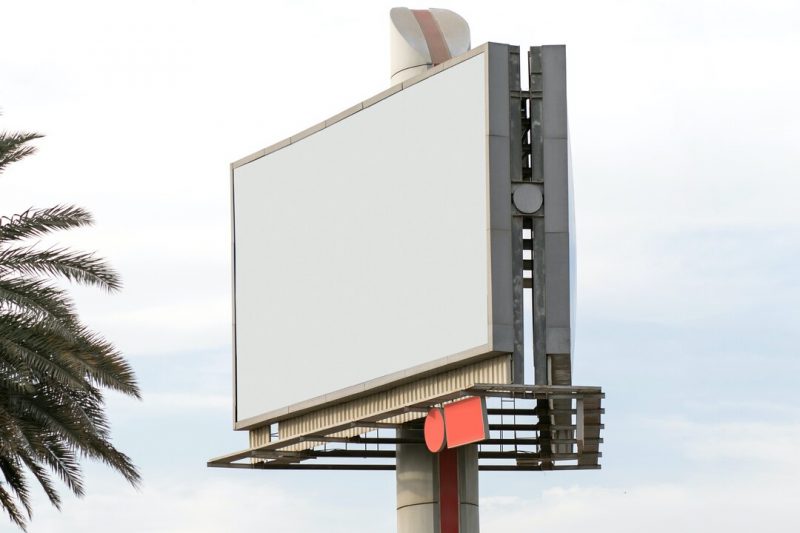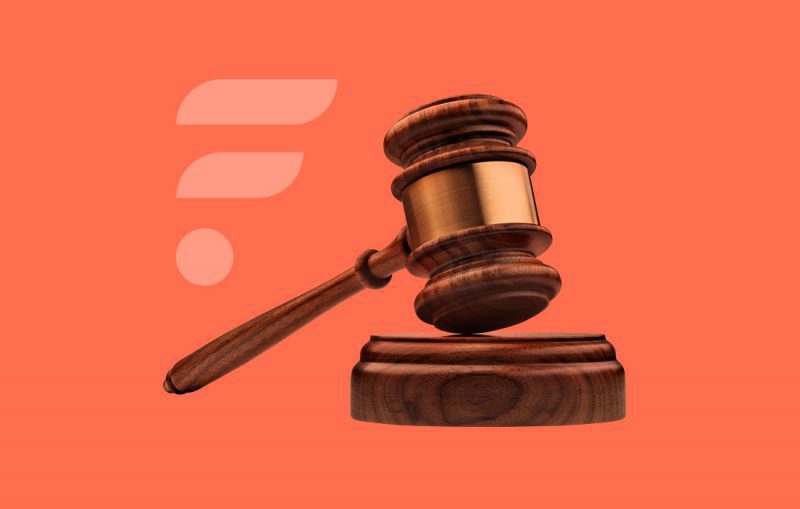
Facebook Ads Guide
The Ultimate Guide to Facebook Ads Bidding Strategies
Advertisers are always struggling with cost stability and an inability to scale, but with the right Facebook ad bidding strategy in place, you will be able to take control and see better results for your campaign.
Bid strategies are essentially cost control tools. They help control your cost per optimisation event in the same way that budgets help control your overall spending. Your bid strategy choice tells Facebook how to bid for your in-ad auctions. Succeeding on Facebook and beating your competitors goes far beyond ad design and powerful copywriting. Optimising your ad bidding strategy is vital to take your campaign beyond the average.
Facebook has changed their bidding methods continually, and this article will show you the most up-to-date tactics and strategies you can implement to achieve the best campaign results, so keep reading.
Keep in mind that failing to place the right ad bid can make you overspend for meagre results, or your ads could underdeliver due to bidding too little.
Is this an auction?

So how does this work? How do you pay for your ads to be seen by your audience? An auction takes place whenever someone is eligible to see an ad. The “participants” in an auction are ads that are targeted to the audience that our eligible person falls into. Basically, when creating a campaign, you are joining a worldwide auction.
The ad that wins an auction and gets shown is the one with the highest total value. Total value isn’t how much an advertiser is willing to pay to show their ad. It’s a combination of three major factors:
- Bid
- Estimated action rates
- Ad quality and relevance
For example, if your ad has received lots of negative feedback, that can decrease its total value. Or, if the person has a history of being interested in what you’re advertising, that can increase its total value. So, the bid is not the only variant to guarantee an impression, although it is probably the most important factor. Facebook tries to satisfy all of its advertisers, but with almost 2 million users worldwide, sometimes, the platform will have to choose just to reward the highest bidders with some exposure.
Let’s run through how this auction actually works. Imagine Facebook only have 3 slots available but 4 different advertisers are bidding for this space:
Advertiser 1: bid $0.3
Advertiser 2: bid $0.9
Advertiser 3: bid $1
Advertiser 4: bid $15
If we ignore the other two variables of an auction and just look at the bidding, we can clearly imagine that Advertiser 1 won’t make it as his bid is too low.
Advertisers 2 and 3 will get a similar number of impressions at a price between $0.9 and $1. Advertiser 4 will clearly get the majority of the impressions, at a price a fair whack higher than Advertiser 3, at around $15. We can guarantee that he won’t be paying $10.
It’s important to understand that if you try to bid too low, you may get no impressions whatsoever, and not achieve your goals.
Highest total value variants
As we mentioned before, an ad wins an auction if it reaches the highest value, which is constituted by three variants:
Bid:
This is pretty much how much you are willing to pay to reach your goals. Remember to be realistic. You still want to be able to see a return from your investment. Facebook is a great platform and it can provide many businesses with amazing results, but it’s never worth it if it’s hurting your profits, instead of adding to them.
 Estimated action rates (EAR):
Estimated action rates (EAR):
Multiple factors contribute to the overall estimated action rate. Previous activity in the ad (shares, comments, likes, views, link clicks…) is the first thing Facebook measures.
Negative feedback is a big deal for the platform. The more negative feedback you have, the worse your ad will perform.
The EAR also looks at ad set, campaign and overall account history. Great account history will always help you as it shows that your ads had a good impact on your audience previously.
Facebook doesn’t really share all the factors that affect EAR, but it’s generally agreed that overall user experience is very important to them.
Ad quality and relevance:
Relevance score is something that only occurs at ad level, and it basically scores whether your ad is well perceived by your audience. Facebook is applying changes to the way its relevance score is calculated. These days, a relevance score is calculated through three new metrics:
- The quality ranking measures the quality of your ad in comparison to others competing for the same audience.
- Engagement rate ranking measures the expected level of engagement your ad will drive in comparison to others competing for the same audience.
- Conversion rate ranking measures the expected conversion rate your ad will drive in comparison to others that are pursuing the same campaign goal and competing for the same audience.
Facebook Bidding Strategies
Now that we know how the Facebook auctions actually work, it’s time to dive into how you should bid on this platform and the different strategies you can approach. Facebook offers its advertisers the following options:

Lowest cost: This tells Facebook to bid with the goal of getting you the lowest possible cost per optimisation event, whilst also spending your entire budget by the end of the day or your ad set’s (or campaign’s) schedule. You can also set a “bid cap”, which sets out the maximum amount Facebook can bid in an auction.
Target cost: This tells Facebook to bid with the goal of achieving an average cost per optimisation event as close to your target cost as possible. This strategy is only available for campaigns using the Lead Generation, App Installs, Conversions or Catalogue Sales marketing objectives.
These two options perform very differently. Let’s see how.
Tip: What is a bid and how does Facebook pace it?
A bid is a number representing how much you value an optimisation event from someone in your target audience. Facebook set your bid for you in alignment with your selected bid strategy. This may include raising or lowering it on an auction-by-auction basis, which is called “pacing” your bid. (The only time Facebook doesn’t pace your bid is if your ad set isn’t performing well or you’re using accelerated delivery.)
Lowest Cost Bid Strategy
The lowest cost bid strategy is formally known as “automatic bidding”, as Facebook will bid on the lowest possible cost per optimized event whilst spending the entirety of your budget.
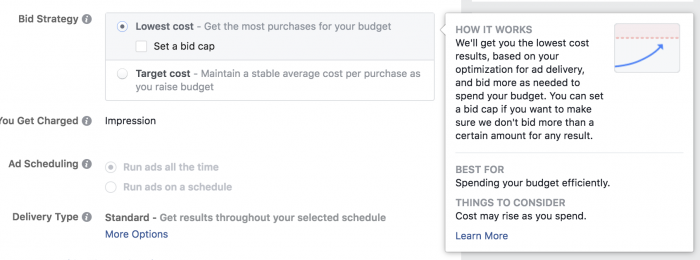
The primary benefit of using this strategy is efficiency. Facebook will try to get you to the lowest cost per event in short term. The drawback is that achieving those low costs may be short-lived. Your results can be unstable as you start spending more as competition increases.
Setting a bid cap
If you are very concerned about how much Facebook will spend using Lowest Cost, you can apply bid capping.
Bid cap will control how much the platform will spend for an event while using the lowest cost bid strategy. Note that this might affect your delivery, as Facebook may struggle to spend your budget under this bid.
The benefit here is that you won’t run any risk of overspending your budget when using this model.

Target Cost Bid Strategy
This bid strategy was formally known as “manual bidding” and is only available for a few objectives: app installs, conversions, lead generation and catalog sales.
This bidding strategy is recommended for achieving more stable results as your spending increases. So, in theory, this is the best bidding strategy for scaling, as you will achieve consistent results.
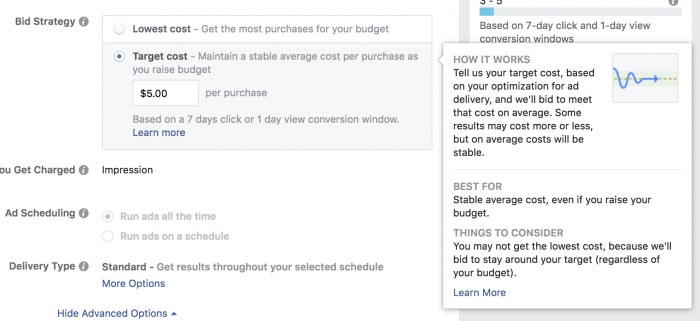
When you decide to go with a Target Cost strategy, you will be required to set a target cost based on the chosen conversion window: 7-day click or 1-day view (which is usually the default).
Again, the main benefit of this strategy is stability and scalability.
The drawback is that you may see a fluctuation in cost until the learning phase is completed (50 events a week).
You also might find that when setting your target cost, the overall cost per event is higher when compared to the lowest cost. So, we would recommend always going for a target bid that is a little bit lower than what Facebook recommends.
Which bid strategy should I choose?
The basic trade-off between these two options comes down to the choice between efficiency and stability.
The lowest cost strategy may produce costs that fluctuate more throughout each day. For example, if auction competition decreases, costs may go down; if auction competition increases, costs may go up.
Facebook though, will always get you the lowest cost per result available at that time of the day. Setting a bid cap, however, can help you avoid Facebook stretching out your budget too much. The target cost bid strategy aims to achieve an average cost per result as close to what you have set as your target as possible, over the lifetime of your campaign. This strategy aims to keep your costs stable every single day, even if you increase or decrease your budget.
Competition, in general, won’t affect your cost per result, but it will affect your delivery and the number of results you achieve per day. For example, more competition means a higher bid. If you are bidding less than what is necessary that day, you will get fewer impressions than usual.
However, Facebook can’t maintain this stability without sometimes skipping less expensive results in favour of the more expensive ones, which generally means a better audience.
If you want to get more out of your budget, then choose the lowest cost strategy.
If you care about having a more scalable, stable campaign, then go for the target cost strategy.
How do bidding strategies affect your budget?

Let’s say you want to get leads for $3 using a $30 budget per day. If you choose lowest cost with bid cap as a strategy, you will be telling Facebook that this is how much you want to bid for a lead. Any conversion higher that that, even if it only costs $3.2, is not interesting to you. Facebook, then, will try to find leads that cost $3 or less. If they find these people, then great! You will spend your budget accordingly.
However, in case Facebook struggles to find leads that cost only $3 you might see a drop in delivery and results for your campaign.
If you choose to go for Target Cost, you will tell Facebook that you want to pay an average of $3 per lead. That means that you are willing to pay a bit less or a bit more for these. This will instruct Facebook to deliver your ads to as many auctions as possible if they see the opportunity for a conversions, even if it means to spend a bit more than planned.
In this case, the platform will try to spend your budget requirements and will hit that, as long as you settle on a realistic bid, that can compete with the market.
At the end, independent of which strategy you choose, you should consider setting up your daily budget to be at least 5 times your bid. This will make your campaigns stable, helping you reach those 50 conversions a week, so you can leave the learning phase.
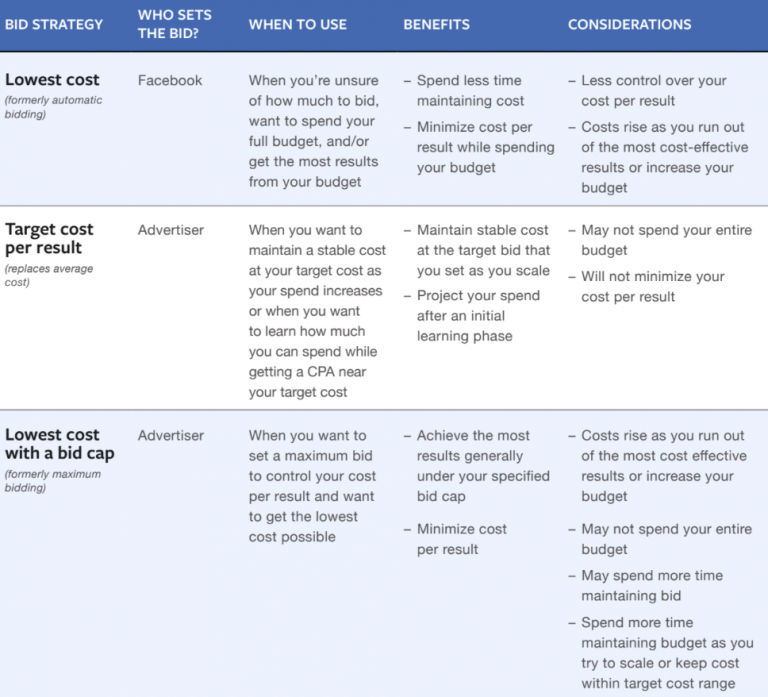
Final thoughts
The basics of Facebook bidding have stayed the same across many years: you are bidding on an action so your ad can be seen by an audience you have chosen.
Many factors contribute to this, but you still need to be clever in terms of how you bid against competitors and the market itself.
Test different approaches and through data, you will come up with the best strategy that will optimise your results and your Facebook marketing campaign as a whole.
Try Demo – Filed, Marketing Software
Follow us on Instagram for blog updates – Instagram, Filed AI



